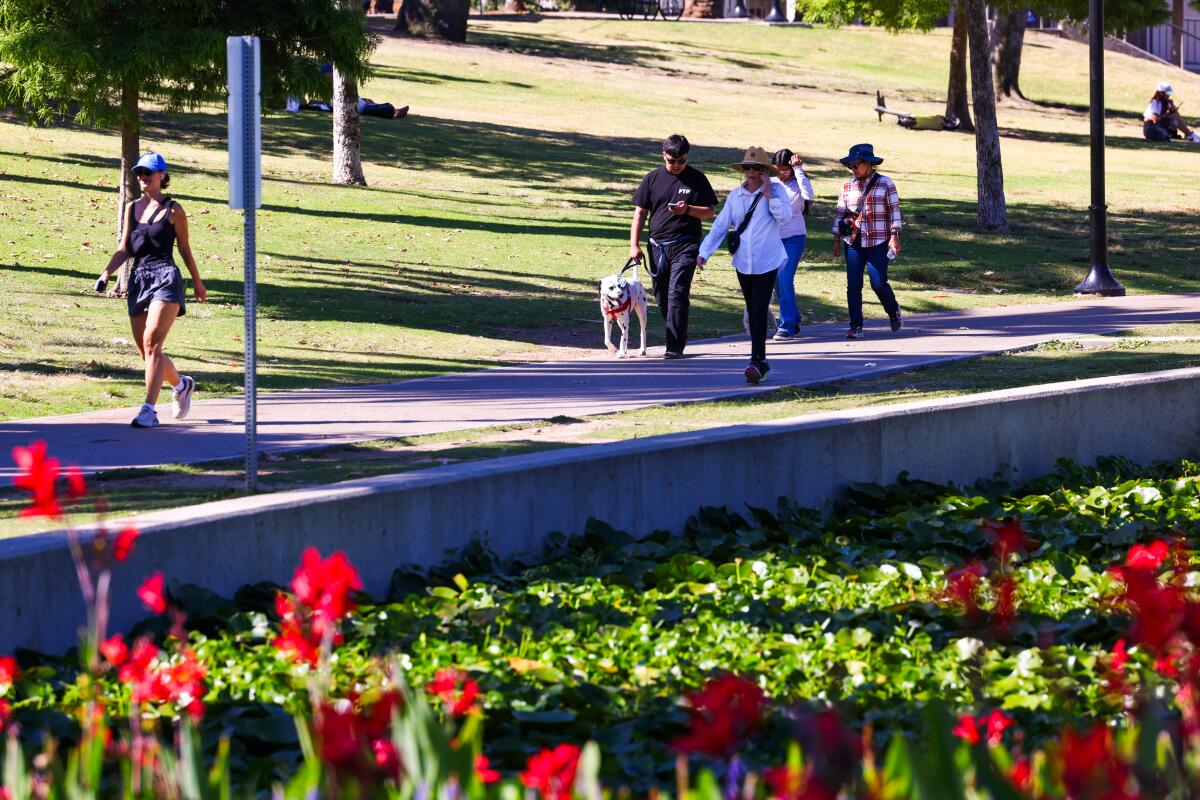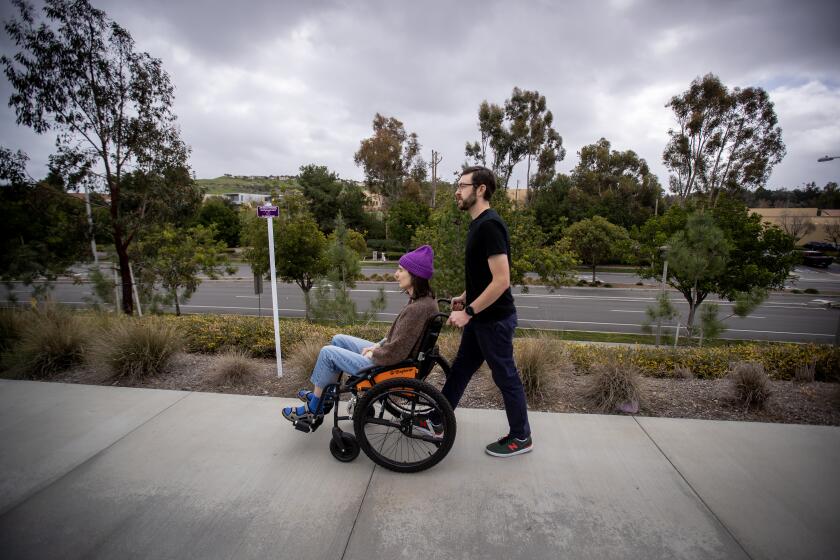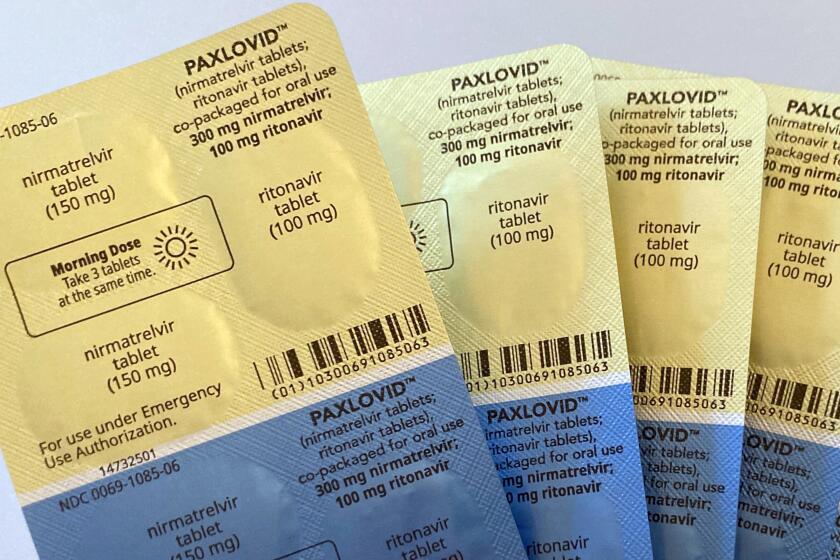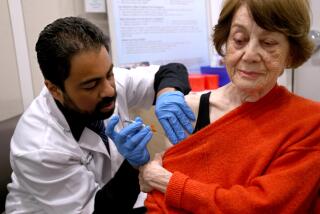‘The virus wants to live.’ California’s big COVID spike isn’t expected to ease anytime soon

- Share via
With COVID-19 numbers in California spiking this summer, experts are warning the new strains driving the spread could be around for some time.
The latest COVID summertime surge is being fueled by what have collectively been dubbed the FLiRT subvariants — a collection of highly transmissible sibling strains that have muscled their way to prominence both in California and nationwide. In doing so, they’ve supplanted last winter’s dominant strain, JN.1, and are presenting new challenges to immune systems not yet primed to keep them at bay.
“It does seem like we are spitting out more and more variants a lot more quickly, and that’s probably to be expected,” said Dr. Elizabeth Hudson, regional chief of infectious disease at Kaiser Permanente Southern California. “This virus is still very, very new to humans, and the virus wants to live, and the way that it lives is by evading immunity” — circumventing people’s defenses by evolving in a way to keep the chain of infection going.
And data show the collective FLiRT family is making itself known in a major way.
Here is a closer look at where California stands with COVID and how to protect yourself.
If it seems like many people around you are getting COVID-19, you’re not alone. Coronavirus levels in California’s wastewater are surging to levels not seen in summertime since 2022.
Why are the FLiRT variants posing such a challenge?
There are quite a few FLiRT variants, which are descendants of last winter’s dominant strain, JN.1. Toward the end of spring, around Memorial Day weekend, that moniker largely applied to just a trio of distinct strains — officially designated KP.1.1, KP.2 and KP.3.
But just when it appeared that those three might be the showstoppers of the summer, an alphabet soup of additional potential threats emerged: KP.3.1.1, KP.2.3, KP.1.1.3, KP.4.1, and KP.1.2.
Of all of them, KP.3.1.1 is most clearly on the rise. For the two-week period that ended July 20, KP.3.1.1 comprised 17.7% of samples nationwide, up from 6.8% for the prior two-week period, according to estimates from the U.S. Centers for Disease Control and Prevention.
KP.3.1.1 “has really taken off,” Hudson said.
COVID cases and hospitalizations rise in L.A. County — and some of those recently reinfected with the FLiRT variants are finding the latest bout the worst yet.
By contrast, the older KP.3 has stagnated. Its share of coronavirus samples was estimated to be 32.9% for the two-week period that ended July 20, down slightly from 33.7% over the prior two-week period.
Those latest CDC estimates mean it’s possible that KP.3.1.1 could be “taking over for the next two or three weeks,” Hudson said Friday. “So, unfortunately, I think we are going to see a lot more cases.”
Isn’t that a lot of strains in such a short period of time?
Yep. But the coronavirus that causes COVID — officially known as SARS-CoV-2 — is still very new to humans and hasn’t settled into the more predictable pattern that public health officials might be aware of for other infectious diseases, such as the flu.
Since emerging in late 2019, the coronavirus has continually evolved in ways meant to evade immune protection. The strains best positioned to infect as many people as possible eventually rise to prominence, a trend that has played out previously in the pandemic with the rise of the Delta and Omicron variants, both of which triggered devastating surges.
As humans gain protection against any particular variant — such as through an updated vaccination or surviving an infection — the virus will seek to evolve in a way to keep the chain of infection going.
“And it may be that this particular summer, we have just seen a lot more of a faster churn of some of the variants, and they’ve just been a little bit more infective,” Hudson said.
It’s also true that, with this being the fifth summer of the COVID era, many people have thrown caution to the wind, and many sick people are continuing to go about their lives without masking or other precautions — allowing the virus to more efficiently spread.
COVID’s spread is being aided by people who are still going to work or traveling while sick. Doctors say it’s important for people who are sick to avoid putting others at risk.
What do the metrics show?
Wastewater: Coronavirus levels in California sewage are considered “very high” for a third consecutive week, the CDC said Friday, following four straight weeks during which viral levels were “high.” For the seven-day period that ended July 20, the most recent data available, coronavirus levels in California wastewater were at 93% of the peak from the summer of 2022. They’ve already exceeded last summer’s high.
Tests: The rate at which California’s COVID-19 tests are turning up positive has now exceeded last summer’s peak. For the seven-day period that ended July 22, 13.8% of coronavirus tests came back positive. Last summer’s maximum was 13.1%.
Deaths and hospitalizations: Overall, deaths and hospitalizations from COVID appear to be lower than last summer. In Los Angeles County, there were an average of 286 COVID-19-positive people in hospitals for the week that ended July 20. That’s flat from the prior week’s figure of 291, and about half as many as last summer’s peak and one-quarter as many as the peak of summer 2022.
After two Olympics were played under COVD-19 restrictions, fans are showing up to the Paris Olympics, much to the delight of athletes and organizers.
What are some prevention tips?
Vaccines: Doctors urge people to consider getting up to date on their vaccinations — particularly if they are at higher risk of severe complications from COVID-19. People should have received at least one updated shot since September, but most people haven’t done so. Those 65 and older should have received a second dose four months after their first. Immunocompromised people should have received one or two doses of the updated vaccine, and may get additional doses two months after their last recommended dose.
Avoid sick people: Some might dismiss their symptoms as a cold, when it could be the start of a COVID-19 illness. “If you have cough-and-cold symptoms, at this point, living in Los Angeles, you should really think that they are COVID until proven otherwise,” Hudson said.
Masking: Masking in public places such as airports has not been required for years. But it can reduce the risk of getting COVID. The strategy can be particularly effective when traveling, such as on a plane. Travel is “a very common, common way that we are seeing people get exposed,” Hudson said.
If exposed: L.A. County health officials recommend close contacts of people who have COVID-19 wear a well-fitting mask around other people for 10 days after their last exposure. They also suggest getting tested three to five days after their last exposure.
The prevalence of long COVID has declined since the start of the pandemic, a new study found, but each new infection carries a risk of developing enduring symptoms.
What if I get COVID?
Testing: Hudson encouraged people to test repeatedly if they have COVID-19 symptoms, even as far out as the fifth day after the onset of illness. People who feel sick might test negative the first couple of days they have symptoms, but end up testing positive later on.
Isolation and masking up: The CDC urges people to stay home and away from others if they’re sick. People can resume normal activities 24 hours after their symptoms have improved and they’ve been fever-free without using medicine such as Tylenol or Advil. But the CDC also advises added precautions for five additional days to avoid infecting others, such as wearing a mask and keeping their distance from others. These precautions should also be followed by people who test positive but have no symptoms, the CDC said.
The L.A. County Department of Public Health suggests that infected people who have symptoms test negative before leaving isolation. The agency also suggests that people who are infected — whether or not they have symptoms — wear a mask around others for 10 days after they start feeling sick or, if asymptomatic, get their first positive test result. However, they can remove their mask sooner if they have two sequential negative tests at least one day apart.
Avoiding the most vulnerable: The L.A. County Department of Public Health also suggests that those who are infected avoid contact with high-risk people for 10 days after the onset of symptoms or their first positive test result. If patients recover and then get sick again, they may have COVID rebound and need to isolate.
Anti-COVID therapeutic drugs are widely available, but some public health officials acknowledge that many still run into barriers trying to get a prescription.
Antiviral treatment: Consider asking a healthcare provider if you can be prescribed an anti-COVID drug such as Paxlovid. Antivirals can be used to treat people with mild to moderate illness who are at risk of seeing their condition deteriorate. Some data suggest that patients who take Paxlovid clear out coronavirus from their bodies faster, and some health officials have said it should be more widely utilized. The state of California once made virtual medical COVID visits free for residents seeking an antiviral prescription, but that program ended in March. The contractor that provided the service, sesamecare.com/covid, now offers those medical services for a fee, though with a discount for California residents.
Beware of COVID rebound: COVID rebound can occur when people with COVID-19 feel better, but then start to feel sick two to eight days after they’ve recovered. Some people may also test positive again. COVID rebound can result in you again becoming infectious. Rebound can happen whether or not you take Paxlovid. If you feel sick again after having recovered from COVID, go back to following the same instructions to stay at home and away from other people during the first phase of the illness.
More to Read
Sign up for Essential California
The most important California stories and recommendations in your inbox every morning.
You may occasionally receive promotional content from the Los Angeles Times.

















